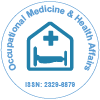Insurance Coverage Projections: Anticipating Future Needs
Received: 01-May-2025 / Manuscript No. omha-25-171465 / Editor assigned: 03-May-2025 / PreQC No. omha-25-171465 / Reviewed: 17-May-2025 / QC No. omha-25-171465 / Revised: 22-May-2025 / Manuscript No. omha-25-171465 / Published Date: 29-May-2025 DOI: 10.4172/2329-6879.1000585
Introduction
Insurance coverage is a critical component of financial protection, providing individuals, families, and organizations with security against unforeseen risks such as illness, accidents, property damage, or loss of income. As societies evolve, demographic shifts, technological innovation, and economic changes continually reshape the insurance industry. Insurance coverage projections—forecasts of future trends in access, demand, and affordability—are essential for policymakers, insurers, and consumers to plan ahead. By analyzing market data and anticipating risks, projections help ensure that insurance systems remain sustainable and responsive to future challenges [1,2].
Discussion
Insurance coverage projections typically examine multiple factors, including population growth, aging demographics, healthcare costs, climate change, and regulatory changes. For instance, in health insurance, rising life expectancy and the increasing prevalence of chronic diseases suggest growing demand for coverage and more comprehensive benefit packages. Similarly, in life and disability insurance, an aging population implies higher claims, prompting insurers to adjust pricing models and coverage terms [3,4].
Technological advancements also play a significant role in shaping future coverage. The rise of telemedicine, wearable health devices, and digital health records will influence health insurance policies, potentially leading to personalized premium rates based on real-time health monitoring. In property and casualty insurance, the increasing frequency of climate-related disasters such as floods, wildfires, and hurricanes creates pressure to expand coverage options while balancing affordability. Projections show that insurers may need to innovate with parametric insurance models—where payouts are triggered by specific events—to meet growing demands efficiently [5-8].
Economic conditions heavily affect coverage projections as well. Periods of inflation or recession can reduce individuals’ ability to pay premiums, leading to coverage gaps. At the same time, insurers must adapt pricing strategies to maintain solvency while staying competitive. Governments also play a pivotal role, as policy reforms and public programs influence the extent of private insurance reliance. For example, projections in many countries suggest continued debates over balancing public health insurance systems with private sector involvement to achieve universal coverage [9,10].
Emerging risks further complicate projections. Cybersecurity threats, pandemics, and global supply chain disruptions are relatively new challenges that demand innovative insurance products. Insurers are increasingly developing cyber insurance and pandemic coverage to meet these evolving needs. Future projections indicate significant growth in these areas as businesses and individuals recognize their vulnerability to non-traditional risks.
Conclusion
Insurance coverage projections provide a forward-looking perspective on how societal changes, technological innovation, and emerging risks will shape the demand and accessibility of insurance. By anticipating challenges such as aging populations, rising healthcare costs, climate change, and new forms of risk, insurers and policymakers can design strategies that ensure sustainability and resilience. Ultimately, accurate and adaptive projections are vital for maintaining insurance systems that protect individuals and communities, ensuring that coverage keeps pace with the evolving needs of a changing world.
References
- Von-Seidlein L, Kim DR, Ali M, Lee HH, Wang X, Thiem VD, et al. (2006) A multicentre study of Shigella diarrhoea in six Asian countries: Disease burden, clinical manifestations, and microbiology. PLoS Med 3: e353.
- Germani Y, Sansonetti PJ (2006) The genus Shigella. The prokaryotes In: Proteobacteria: Gamma Subclass Berlin: Springer 6: 99-122.
- Aggarwal P, Uppal B, Ghosh R, Krishna Prakash S, Chakravarti A, et al. (2016) Multi drug resistance and extended spectrum beta lactamases in clinical isolates of Shigella: a study from New Delhi, India. Travel Med Infect Dis 14: 407–413.
- Taneja N, Mewara A (2016) Shigellosis: epidemiology in India. Indian J Med Res 143: 565-576.
- Farshad S, Sheikhi R, Japoni A, Basiri E, Alborzi A (2006) Characterizationof Shigella strains in Iran by plasmid profile analysis and PCR amplification of ipa genes. J Clin Microbiol 44: 2879–2883.
- Jomezadeh N, Babamoradi S, Kalantar E, Javaherizadeh H (2014) Isolation and antibiotic susceptibility of Shigella species from stool samplesamong hospitalized children in Abadan, Iran. Gastroenterol Hepatol Bed Bench 7: 218.
- Sangeetha A, Parija SC, Mandal J, Krishnamurthy S (2014) Clinical and microbiological profiles of shigellosis in children. J Health Popul Nutr 32: 580.
- Ranjbar R, Dallal MMS, Talebi M, Pourshafie MR (2008) Increased isolation and characterization of Shigella sonnei obtained from hospitalized children in Tehran, Iran. J Health Popul Nutr 26: 426.
- Zhang J, Jin H, Hu J, Yuan Z, Shi W, Yang X, et al. (2014) Antimicrobial resistance of Shigella spp. from humans in Shanghai, China, 2004–2011. Diagn Microbiol Infect Dis 78: 282–286.
- Pourakbari B, Mamishi S, Mashoori N, Mahboobi N, Ashtiani MH, et al. (2010) Frequency and antimicrobial susceptibility of Shigella species isolated in children medical center hospital, Tehran, Iran, 2001–2006. Braz J Infect Dis 14: 153–157.
Citation: Selam A (2025) Insurance Coverage Projections: Anticipating Future Needs. Occup Med Health 13: 585. DOI: 10.4172/2329-6879.1000585
Copyright: © 2025 Selam A. This is an open-access article distributed under the terms of the Creative Commons Attribution License, which permits unrestricted use, distribution, and reproduction in any medium, provided the original author and source are credited.
Select your language of interest to view the total content in your interested language
Share This Article
Recommended Journals
Open Access Journals
Article Tools
Article Usage
- Total views: 152
- [From(publication date): 0-0 - Dec 19, 2025]
- Breakdown by view type
- HTML page views: 124
- PDF downloads: 28
